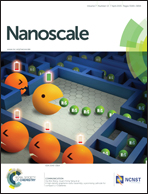Modelling energy deposition in nanoscintillators to predict the efficiency of the X-ray-induced photodynamic effect†
Abstract
Scintillating nanoparticles (NPs) in combination with X-ray or γ-radiation have a great potential for deep-tissue cancer therapy because they can be used to locally activate photosensitizers and generate singlet oxygen in tumours by means of the photodynamic effect. To understand the complex spatial distribution of energy deposition in a macroscopic volume of water loaded with nanoscintillators, we have developed a GEANT4-based Monte Carlo program. We thus obtain estimates of the maximum expected efficiency of singlet oxygen production for various materials coupled to PS, X-ray energies, NP concentrations and NP sizes. A new parameter, ηnano, is introduced to quantify the fraction of energy that is deposited in the NPs themselves, which is crucial for the efficiency of singlet oxygen production but has not been taken into account adequately so far. We furthermore emphasise the substantial contribution of primary interactions taking place in water, particularly under irradiation with high energy photons. The interplay of all these contributions to the photodynamic effect has to be taken into account in order to optimize nanoscintillators for therapeutic applications.


 Please wait while we load your content...
Please wait while we load your content...